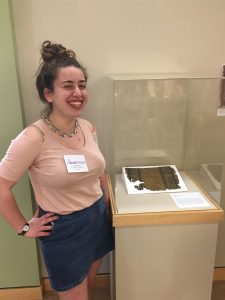by Rachel Grand (BMC ’21)
Student curator Rachel Grand ’21 at opening of ReconTEXTILEize, the 360 course cluster’s exhibition that helped prepare her to organize her own exhibition this fall.
I began my internship with Special Collections as part of the Museum Studies Praxis course, where students find placements in local museums for a practical learning experience. I was placed with a History of Art PhD candidate, Nina Blomfield, who is curating an exhibition in the fall on Lockwood de Forest’s decorative arts program for the College. My initial assignment was to help with her research, but it grew into an opportunity to curate my own smaller exhibition in conjunction with hers on Marcel Breuer, another artist commissioned to design furniture for the College. Compared to my past internships, I felt extremely fortunate for this opportunity with Special Collections because of the real responsibilities that were entrusted to me. In this internship, I felt that the research that I produced for Nina was valued and impactful, and the exhibition that I was able to curate myself, has taught me an invaluable amount about curatorial work. Because of the research opportunities afforded to me in Special Collections, I learned more about the history of Bryn Mawr College than I ever expected to know about my temporary home.
Lockwood de Forest was a designer and architect who first came to Bryn Mawr College in the 1890s. His boss, and friend, was none other than M. Carey Thomas, for whom he designed and decorated a significant portion of her residence and other parts of campus. De Forest is not a well-known name nowadays among students and faculty, compared to M. Carey Thomas, so it was surprising to learn that his architectural touch is all over the College, from the campus center and health center, to the ceiling of the Great Hall! When I walk around on campus now, knowing the history of the buildings enforces a sense of home. While reading correspondence between de Forest and Thomas, I got a sense of Thomas’ strong will, in regard to both interior decoration as well as the future of the college, which provided me with an educated perspective, amidst the controversy surrounding the renaming of Old Library.
The second artist that I studied, Marcel Breuer, was commissioned for a specific project on campus. When Rhoads was built in 1937, he was approached by the college to design a set of furniture for the new dorm rooms. Marcel Breuer was a famous designer and architect who was trained at the Bauhaus, a radically modern art school in Weimar Germany.
In order to learn more about Breuer’s furniture, I looked through the college’s archives. As I searched, I could not help but notice how the College used to place an emphasis on Bryn Mawr being “male friendly.” The yearbook from 1939 boasted that women who lived in Rhoads were more likely to be engaged (to men) than any other dorm. Photographs of students in Rhoads dining hall in the 1960s depicted at least one man in each group of smiling students.
I am told that the student body here has changed in recent years and learning more about the college’s history has only confirmed that. Today, Bryn Mawr students would not tolerate M. Carey Thomas, her elaborate expenditures, nor yearbooks boasting their marriageability. It was very impactful to be able to situate myself, as a student, in the timeline of Bryn Mawr’s past through this research at Special Collections.
Rachel’s exhibition, Bauhaus at Bryn Mawr: Marcel Breuer’s Furniture for Rhoads, opens October 24 in the Coombe Suite Display Case on the second floor of Canaday Library.

